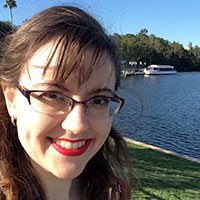By Children’s Librarian Shelley Harris
So you, your child, or your student has been diagnosed with autism? Congratulations! As overwhelming as it can be to hear a diagnosis, you are now ready to find and receive the supports you need to live the life you want for yourself.
There are a lot of negative and scary stories about autism in books, movies, the news, and more. Autism, however, is not inherently negative or scary! There are a wide variety of experiences, and you have joined a rich, vibrant community that is full of as much joy as challenge.
What is autism?
Autism is a bundle of diagnoses that impact how you experience the world. You can have different aspects, like dyspraxia or a communication disorder, without being autistic.
Rebecca Burgess at Geek Club Books wrote a comic illustrating what the autism spectrum really looks like and why every autistic person can experience things differently (available in English, Spanish, French, German, and Indonesian).
The Thinking Person’s Guide to Autism prides itself on being a one-stop source for carefully curated, evidence-based, neurodiversity-steeped information from autistic people, parents, and autism professionals. Co-founder Shannon Des Roches Rosa shares the advice she wishes she’d been given when her son was diagnosed and is grateful autistic people helped her understand autistic joy and the best kind of supports.
Want to learn more? Check out some of these resources below!
Learn about autism from autistic adults
Even if they don’t seem anything like your own experiences, you often will have a lot more in common than you think. Because media and the news often share only one, narrow way to be autistic, it’s hard to understand all of the different ways autism can look. Look for organizations that have autistic people in leadership roles.
Here are some excellent people to learn from:
- Nicole Filippone is an autistic author and mother to two neurodivergent children. She shares her experiences and great resources on the Sensory Stories Facebook page.
- Lei Wiley-Mydske is an autistic woman, daughter of an autistic man, and mother to autistic children. She created the Ed Wiley Autism Acceptance Library in honor of her father, and created the Neurodivergent Narwhals series, with guides for parents and therapists to honor their child and their diagnosis. We love to display her Narwhals all year long!
- While stereotypes say that mostly boys have autism, that isn’t the case. Because girls may not present in the stereotypical way, they are diagnosed less often. The Autistic Women and Nonbinary Network (AWNN) has great resources, including a welcome packet for girls and for parents.
- Amethyst Schaber runs a YouTube channel called Ask an Autistic, where she covers a lot of important topics like masking, stimming, and burnout.
- Jordyn Zimmerman is a non-speaking autistic woman who uses an augmentative communication device to communicate. For most of her education, teachers thought that because she couldn’t speak, she couldn’t think, and she responded by running and lashing out. It wasn’t until she was 18 that she found educators who saw her and taught her. A documentary about her story, This is Not About Me, is available to rent on Kinema and Apple TV. She recently presented to the Interagency Autism Coordinating Committee with her story and recommendations to help more autistic students succeed in school and life.
- Twitter hashtags are a great way to see autistic people sharing their experiences in their own space. My favorite to follow are #AutisticJoy and #ActuallyAutistic.
Online resources to explore
- NPR recently posted an article interviewing autistic social psychologist and author Devon Price and sharing his tips for autistic people to stop masking. Masking is when autistic people try to hide their autistc traits, and is something autistic girls often excel at. This generally causes a great deal of stress and long-term harm. Dr. Price also talks about how girls and children of color are much less likely to be properly diagnosed.
- Learn from Autistics has a guide for talking to your child about their autism diagnosis. Their site is full of guides and links to more resources, like the Autism Self-Advocacy Network.
- Michelle Swan has guides specifically for educators who have autistic students.
- This post from We Need Diverse Books goes into the changes we are slowly seeing in autism representation for children, and the importance of autistic authors.
What your library offers
- We have a social narrative for visiting the Main Library Children’s Services available on our website (pdf) and at the Children’s Services desk.
- Visiting us or another library for the first time? We have tips for helping your first visit be successful.
- All three library buildings have support bins with items like noise-canceling headphones, wiggle seats, fidget toys, DIY schedules, pinwheels, sunglasses, and weighted lap pads.
- Supported programs at the library have visual schedules, fidgets, and other supports for children built into the class. Look for supported storytimes and supported gardening to return in summer 2022!
- We have been making short videos for children throughout the pandemic, and some of them are specifically supported videos, with language modeling, sign language, schedules and other visuals.
- Disability Reads is a list of kids books for kids with and without disabilities, with an emphasis on disabled creators. This list is updated every July for Disability Pride Month, so keep an eye out for new titles soon!
- We are hosting a screening of This is Not About Me on April 30 at 2pm. This film is appropriate for parents, caregivers, and educators. Register now »

About Shelley
Shelley is a children’s librarian with a passion for early literacy, serving and celebrating the disability community, and exploring technology. She can often be found practicing storytime songs with her black lab, Bingo.

